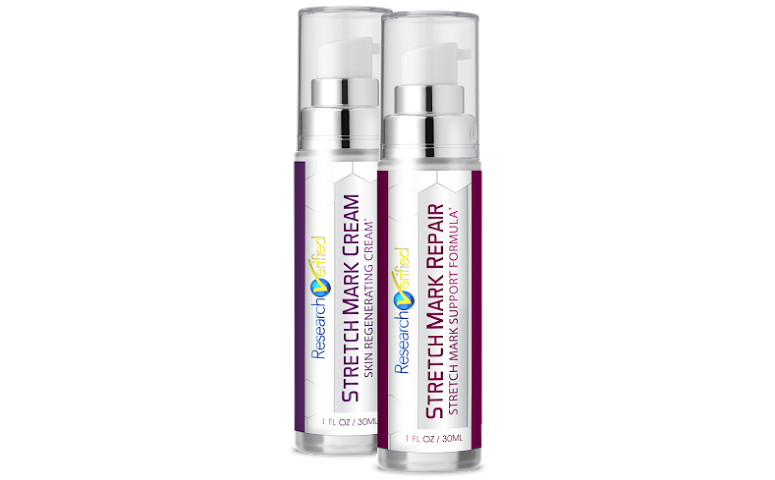While we expectant mommies know we have to make space for our new baby - space in our home, space in our time and schedule, and of course, space in our own body - there can sometimes be some unwelcome effects. One undesired effect of making space for the baby in our own body is that we are prone to develop stretch marks as our skin tries to keep up with the demands of a fast-growing baby inside. This article will provide you with some information about stretch marks during and after pregnancy as well as what preventative steps to take to reduce the chance of developing them, and then we will examine what one should look for when choosing a product to repair the skin if stretch marks do develop. We will then review one product in particular - Research Verified Stretch Mark Repair - that has received top marks for its usefulness in treating these unwelcome marks.
What Causes Stretch Marks During Pregnancy?
As the baby is growing quickly and mommy-to-be is gaining weight, the skin stretches to accommodate the added load. Sometimes, particularly with rapid weight gain, the skin cannot keep up with the rate of growth, and this causes the elastic fibers just under the surface of the skin to break. For people with a lighter complexion, these marks will usually appear as a pinkish color, whereas for women with darker skin the marks typically are lighter than the skin tone. The color of the marks usually change over time, typically getting fainter with time. The marks typically appear on the belly and breasts, and sometimes also on the thighs, buttocks, and upper arms - areas of weight gain.
Who is Most Likely to Get Stretch Marks?
Research shows that 90% of women will get stretch marks during their sixth or seventh month of pregnancy, and a women's genetic makeup does play a factor as to whether they will develop the marks or not. Many women find that on second pregnancies and beyond the marks may become even more pronounced.
Can Stretch Marks be Avoided?
There are multiple tactics that one can employ to try to prevent getting stretch marks during pregnancy. The more that the skin remains elastic, supple and well-hydrated the less the likelihood of developing stretch marks. Many women report that diet, exercise, and topical treatment are the three elements for success.
- Diet to Follow to Prevent Stretchmarks: Since the skin needs to stay supple, it goes without saying that every expectant mom's diet should include plenty of water, approximately 2 liters per day. In addition, certain foods may be helpful, particularly foods that are rich in Vitamin E and C, zinc and silica, which all help to form collagen. It is the collagen and elastin fibers in the skin that are prone to break as the skin expands, so the stronger these fibers are, the less likely they are to break. Other nutrients you may wish to include in your diet are Vitamins B2 (Riboflavin) and B3 (Niacin), which may help to keep one's skin healthy.
- Exercise and Controlled Weight Gain: Experts say that a healthy weight gain during pregnancy should be about 25-35 pounds. Thus, keeping one's weight gain to no more than 35 pounds helps to prevent stretch marks, and exercise (within the parameters of what types of exercise is safe during pregnancy) can help one to remain within the weight gain limit. In addition, exercise has its own beneficial effect on the skin, for results in improved blood circulation which also helps to keep the skin elastic. Improved circulation can also make it less likely to develop other unwanted conditions such as varicose veins and swollen ankles.
- Topical Treatment for Repair and Prevention of Stretch Marks: In addition, it is recommended from the first trimester of pregnancy to begin to apply some sort of topical oil to the skin at least twice daily. This will help to keep the skin hydrated and supple and reduce the risk of developing the marks.
What Treatment Should I Look For to Remove Stretch Marks if I Develop Them?
Despite all of one's efforts, sometimes even the most attentive mother-to-be will find that she cannot avoid getting stretch marks during her pregnancy. And since most women do end up developing stretch marks, it is no surprise that the market is loaded with products all boasting that their treatment is best for removing these unwanted marks. So how do you assess which treatment really works? There are several factors to consider.
- Ingredients Matter - When selecting a cream or gel, you should look to see if the product contains the following research-proven ingredients: Allium Cepa (onion) bulb extract, Aloe barbadensis (aloe vera) and Emu, Safflower, Sunflower and Jojoba Oils.
- Safety and Purity - You will want to make sure that the treatment is safe and that the ingredients have been tested for purity, ideally through an impartial, third-party tester. The product should comply with the highest standards on the market, such as FDA, cGMP, and US Pharmacopeia standards of safety and quality.
- Two-Treatment Solution - When dealing with skin repair creams, there are certain products that are developed to achieve two goals: heal the skin blemish externally, and also repair the internal tissue within the skin. It is important to find a product from a manufacturer who you trust has based their product on clinical research so that the ingredients and quantities of the ingredients maximize these two goals.
Which Product is Recommended for Stretch Mark Repair?
One product that really seems to stand out from its competitors is the Stretch Mark Repair product manufactured by a company called Research Verified. In our Research Verified brand review, you will discover more about this incredible manufacturer that is making a huge difference in peoples health.
This product comes as a Stretch Mark Repair Gel and Stretch Mark Rejuvenation Cream, which are designed to be used in tandem with one another. There are a number of reasons why this product excels.
First of all, the manufacturer is committed to basing the product on clinical research, and the ingredients and dosages are all based on research. Second, the ingredient list contains the top ingredients as outlined above. Next, the manufacturer meets all the standards of purity and safety as outlined above, even utilizing third-party testing on their product. And finally, Stretch Mark Repair is designed to both repair and rejuvenate the skin, for external as well as internal skin healing, when the gel and cream are used in tandem with one another.
One more thing that makes this manufacturer really stand out above the rest is their impressive 365-day money-back guarantee - on any product you are not satisfied with, whether used or unused, you have a full year to return it. This indicates the confidence that the company has with their product, and, indeed, the positive customer reviews share this enthusiasm.
Conclusion of Our Research Verified Stretch Mark Repair Review
In conclusion, stretch marks during pregnancy are unwelcome, but there are preventative methods as well as repair treatments out there that can help. First of all, to try to prevent stretch marks, every expectant mommy should attend to her diet, hydrate herself with plenty of water, get proper exercise, and apply a topical ointment from the first trimester and on. If, despite her efforts, she does develop stretch marks, she should seek out an appropriate treatment to repair and rejuvenate the skin. Of all the products out there, our review has found that Research Verified Stretch Mark Repair stands out above the others, and it would be a good choice for dealing with any stretch marks that develop.















